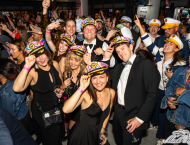Music
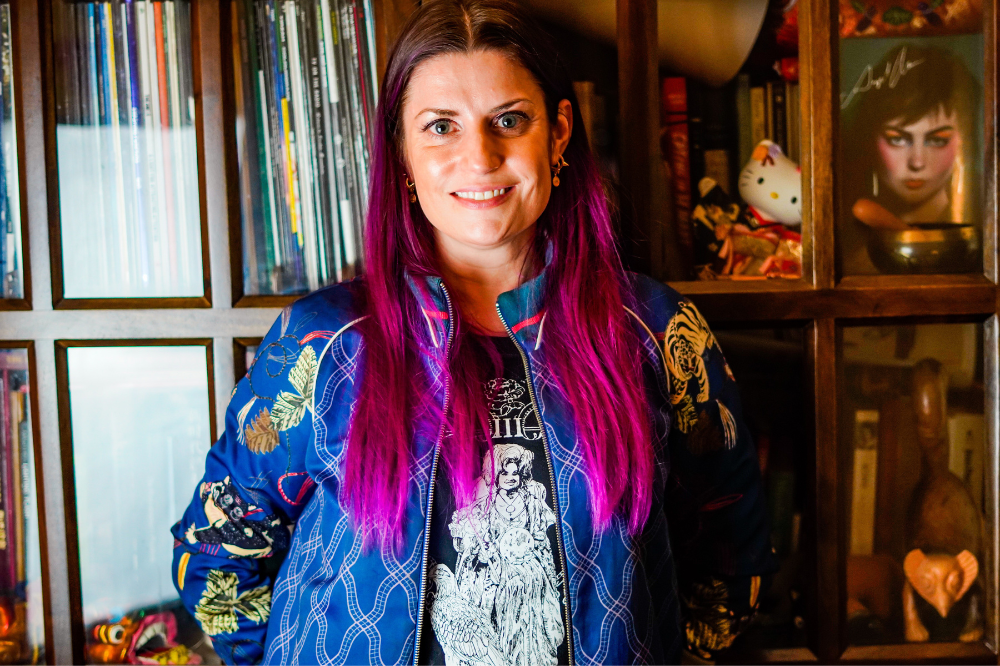 Sandy Coburn. Photo by Andrew J. Williams III
Sandy Coburn. Photo by Andrew J. Williams III
In Kansas City, We Grow Audiophiles: The Romanticism of Vinyl
November 1, 2022 @ 12:00pm
Vinyl is having a moment. Its swift resurgence signals the medium has recaptured some major cultural currency; if retro is in vogue, then for many audiophiles, vinyl stands at the zenith of cool.
For casual enthusiasts, what defines “cool” might be up for debate.
For collectors like Sandy Coburn, who’s amassed more than 350 records in four years, it’s about consuming music in its purest, most preserved form.
“There is this richness to records, this romanticism [around] the large format of vinyl, the needle hitting the vinyl and [setting] up your speakers to capture all of these deeper tones,” Coburn says.
As we meet on an early fall evening in her Northwest D.C. hideaway, I’m transfixed by the chaotic harmony of her sanctum: various flora and fauna, disco balls, a menagerie of earth tones, a splash of pink from her Hello Kitty guitar case, a cherished framed Björk poster, a plush camel leather couch, an authentic Moroccan rug and lamp, a Tibetan cabinet, other tchotchkes procured from around the world and her pet rabbit, Truman.
It’s the perfect backdrop for a wide-ranging exploration of her musical beginnings and eventual foray into vinyl.
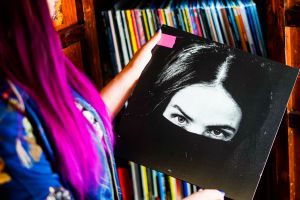
Photo by Andrew J. Williams III.
The Birth of Cool
Coburn hails from Lee’s Summit, Missouri, a suburb of Kansas City with a population of just over one hundred thousand. The humble suburb is a far cry from her flowing purple and black hair.
Kansas City, which Coburn describes as “frozen in time hipster,” carries some clout in music circles. The city was once predicted to become the next great music scene following the end of Seattle’s iconic ’90s era, a prophecy that never came to fruition.
Still, music is dyed into the region’s fabric; Coburn recalls how commonplace it was for people you knew to be in a band or spend their weekends seeing different live acts.
As a child, Coburn’s mother wanted her to be a concert pianist and she began playing the instrument at the age of 4, including enduring what she describes as “very long lessons” up until 17.
“I’ve always been very attuned to music,” Coburn confesses.
In those early days, ever the revolutionary soul, she took her cues from rock, pop, the radio and old piano books that exposed her to a variety of ’80s songs, and poured them into her mastery of the piano. Key by key, her curiosity grew.
As she got older, she added the violin and guitar. She also soaked up influences from family on her mother’s side, including an uncle, Bobby McCarty, who was a member of the semi-famous ’70s band The Fun Company, and her great aunts, who formed a musical trio called The McCarthy Sisters.
“I remember staying over at my grandparents’ house and people would get out guitars and that would be what you would do on a Saturday afternoon; people would sit around playing guitars and my grandpa would usually be singing along to Willie Nelson.”
Though, the definitive era in her musical timeline was her teens.
“I started realizing that a lot of friends had these cool older siblings,” Coburn admits, who she remembers owning very eclectic music palettes.
They introduced her to one of her greatest musical influences, MTV’s “120 Minutes,” a television program dedicated to alternative music that ran from 1986 to 2000.
It was this same group of seasoned connoisseurs that gifted her albums like The Smiths’ “The Queen Is Dead,” a group who’d long ago broken up, and Jane’s Addiction’s “Ritual de lo Habitual,” alongside an anthology of bootlegged albums and playlists, offerings Coburn eagerly devoured and used to shape the foundation of her melodic tastes.
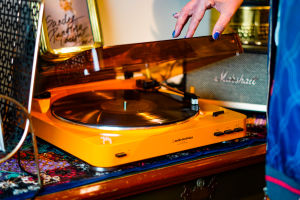
Photo by Andrew J. Williams III.
The Lost Spotify Decade
Fast forward to 2011 and Coburn’s decision to move to D.C. To ease the transition, she digitized her collection of music and books. Then, a year into arriving in the DMV, the unthinkable happened: a hard drive crash.
“A lot of those unique things from my youth — [one-night only] performances and bootlegs — were lost forever,” Coburn laments. “That reemphasized the need for having a physical collection.”
For years after the agony of losing an irreplaceable digital library, Coburn leaned into streaming platforms to quench her thirst for new music. She considers it The Lost Spotify Decade, a time of purely digital consumption and the genesis of her “at the moment” playlist, where, on a weekly basis, she continues to rotate tracks on and off — currently clocking in at 33+ hours and 520+ songs.
Coburn, meanwhile, continually yearned to shrink the physical distance between herself and her music, getting her fixture from the energy of live performances until she couldn’t anymore.
A Sea of Black Tees
Coburn, who is a bonafide melomaniac and attends three concerts nearly every week — as she has since arriving in the District — recently traveled to New York to see the popular alternative pop band Japanese Breakfast, American indie rock band the Yeah Yeah Yeahs and the all-girl rockers The Linda Lindas on tour together.
“I started realizing [in 2018] my wardrobe had turned into a sea of black concert tee shirts,” Coburn jokes.
This fueled her decision to purchase vinyl as an alternative way to support bands, rather than stockpiling more concert tees, which gave birth to a full-blown love affair.
“I started remembering some of the things I really enjoyed about having a physical collection,” Coburn says.
She describes her affection for album art and “feeling more in tune with her music” through access to visual lyric books, which add a welcomed layer to the internalizing of verses, hooks and lyrical emotion. She appreciated the space to interact with her vinyl on multiple levels: touching, hearing and sensing.
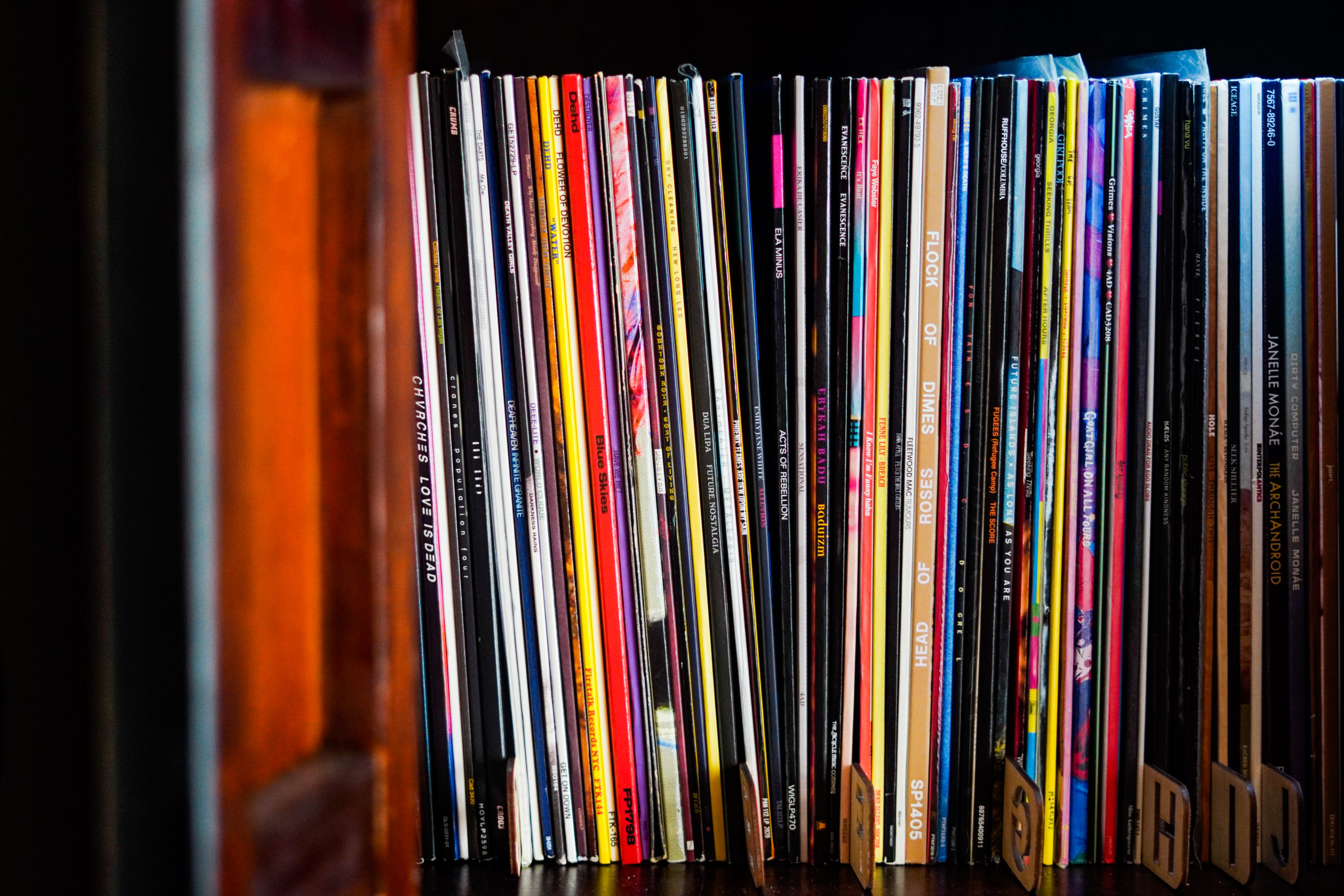
Photo by Andrew J. Williams III.
In the process, she also recaptured “experiencing an album in its holistic form as the artist intended,” a sentiment often lost when songs are ingested through patchwork playlists.
“I try to get familiar with a number of artists, so having a ton of playlists is really important to me,” Coburn explains. “But [you lose] this degree of intimacy you have with vinyl. An album really should be a collection that’s cohesive; some albums tell stories from start to finish.”
Drop the Needle
Then came the onset of Covid-19 and with it the emptying of music venues. Unable to see up-and-comers in the flesh, the new reality accelerated the growth of Coburn’s collection.
“I was no longer going to those two to three concerts a week,” Coburn says. “And that was what made me realize I wanted a [deeper] musical experience [while isolated]. I started leaning into the vinyl collection pretty heavily.”
The experience filled the concert void and soothed pent-up anticipatory energy, the kind that manifests when hearing a favorite artist for the first time on the stage. It also inspired Coburn and her friends to begin hitting the road, scouring the East Coast in search of vinyl shops, in towns big and small.
The current iteration of Coburn’s meticulously alphabetized and organized collection is an amalgamation of indie, dark wave, synth pop, punk, garage rock and electric. There’s also a spattering of dance, disco, R&B, classic ’90s, early 2000s and a dash of J-Pop.
The versatility of Coburn’s compendium gives it adaptability to her mood.
“I’ve got this room set up as a library; it’s got my books, vinyl and comics. I tend to put on a record and try to read. But I have a lot of rock, punk and dance and that doesn’t work for sitting around — there’s also [music for] dancing around the apartment or playing with the bunny.”
The collection is a living, breathing assemblage. As she considers how best to guide fledgling collectors, Coburn points to places like yard sales as gold mins for rare finds from bygone eras.
“That’s the fun thing about vinyl: You’re [always] hunting for that next thing.”
Yet, vinyl stores and vinyl store staff remain tried and true resources, where the search for one record can easily spitball into the purchase of several albums.
For Coburn, collecting vinyl must be a subjective journey.
“A vinyl collection is like a book collection,” Coburn insists. “It’s supposed to be something you have with you for the rest of your life, that you’re going to enjoy for the rest of your life. So don’t hop on the latest trend or what you think is going to be valuable. Think of what’s valuable to you and purchase that.”
Visit discogs.com to begin cataloging your vinyl collection and/or locate hard-to-find albums from among the hundreds of thousands of contributors. You can follow Sandy Coburn on her Instagram @sandy_coburn.
SANDY’S COLLECTION
Album count
359
Most represented artist
Björk
Full anthology
Sault
Most listened to album of 2022
“I’m Not Sorry, I Was Just Being Me” by King Hannah
Oldest album
“Germfree Adolescents” by X-Ray Spex
Most recently purchased album
“Ic3peak” by IC3PEAK
Pet
One mischievous rabbit named Truman
Enjoy this piece? Consider becoming a member for access to our premium digital content. Support local journalism and start your membership today.







